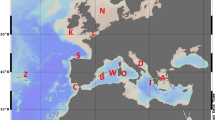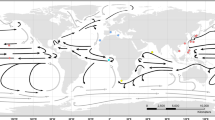Abstract.
The loliginid squids Loligo pealei LeSueur and L. plei Blaineville (both recently proposed for reclassification as Doryteuthis) are commercially important, similar in appearance, and sympatric throughout much of the northwestern Atlantic Ocean, the Gulf of Mexico, and the Caribbean Sea. To investigate possible cryptic speciation and population structure, we examined samples (collected from 1995 to 1997) of both species for restriction fragment length polymorphisms (RFLPs) in PCR products of the mitochondrial gene cytochrome c oxidase (subunit I). RFLP haplotypes were further characterized by direct sequencing. In North American waters, cryptic speciation was rejected by the far greater nucleotide sequence divergence between species (~14%) versus within species (<1%). Each species displayed about a dozen RFLP haplotypes, but only three of their respective haplotypes were found among 90% of L. pealei specimens (n=356) and 97% of L. plei specimens (n=431). For L. pealei, a genetic break existed between the northern Gulf of Mexico and the Atlantic Ocean; among sample units within each population, gene flow was consistent with panmixia. The phylogeography of L. pealei is likely a consequence of the eastward currents of the Florida Straits, the elevated temperatures of those surface waters, and the restriction of this species to the continental shelf. For L. plei, a genetic break existed between longitudes 88°W and 89°W, with the northwestern Gulf of Mexico and the northeastern Gulf–Atlantic Ocean comprising separate populations; among sample units within each population, gene flow fit an isolation-by-distance model. If the genetic break found for L. plei represents resident populations separated by nearshore physical parameters (e.g. effects of the Mississippi River and the sediment boundary at longitude 88°W), the lack of structure within the Gulf for L. pealei might be due to its distribution farther from shore. However, the two populations of L. plei probably represent annual recolonization from the southwestern Gulf of Mexico and from the eastern Caribbean Sea, whereas the populations of L. pealei probably are permanent residents within their respective regions.
Similar content being viewed by others
Author information
Authors and Affiliations
Additional information
Electronic Publication
Rights and permissions
About this article
Cite this article
Herke, .S., Foltz, .D. Phylogeography of two squid (Loligo pealei and L. plei) in the Gulf of Mexico and northwestern Atlantic Ocean. Marine Biology 140, 103–115 (2002). https://doi.org/10.1007/s002270100680
Received:
Accepted:
Issue Date:
DOI: https://doi.org/10.1007/s002270100680




